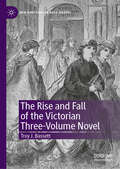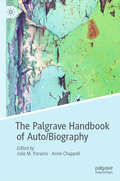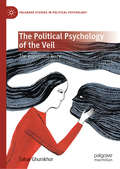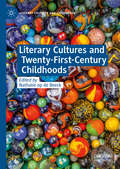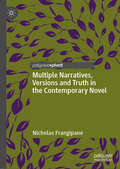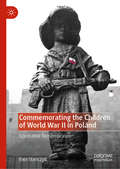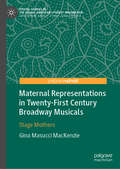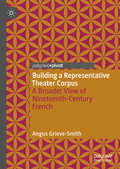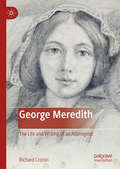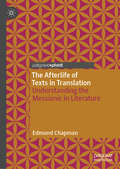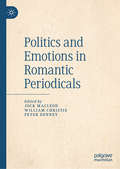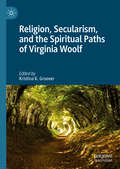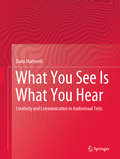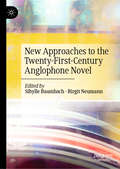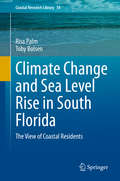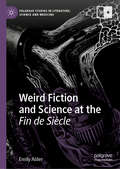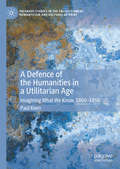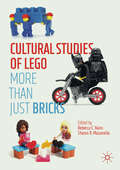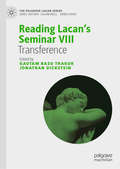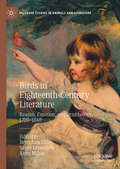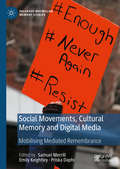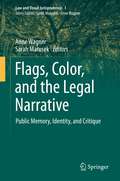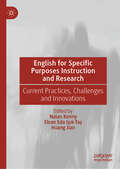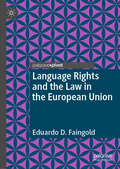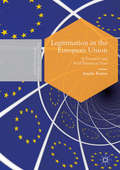- Table View
- List View
The Rise and Fall of the Victorian Three-Volume Novel (New Directions in Book History)
by Troy J. BassettUtilizing recent developments in book history and digital humanities, this book offers a cultural, economic, and literary history of the Victorian three-volume novel, the prestige format for the British novel during much of the nineteenth century. With the publication of Walter Scott’s popular novels in the 1820s, the three-volume novel became the standard format for new fiction aimed at middle-class audiences through the support of circulating libraries. Following a quantitative analysis examining who wrote and published these novels, the book investigates the success of publisher Richard Bentley in producing three-volume novels, the experiences of the W. H. Smith circulating library in distributing them, the difficulties of authors such as Robert Louis Stevenson and George Moore in writing them, and the resistance of new publishers such as Arrowsmith and Unwin to publishing them. Rather than faltering, the three-volume novel stubbornly endured until its abandonment in the 1890s.
The Palgrave Handbook of Auto/Biography
by Julie M. Parsons Anne ChappellIn a neo-liberal era concerned with discourses of responsible individualism and the ‘selfie’, there is an increased interest in personal lives and experiences. In contemporary life, the personal is understood to be political and these ideas cut across both the social sciences and humanities.This handbook is specifically concerned with auto/biography, which sits within the field of narrative, complementing biographical and life history research. Some of the contributors emphasise the place of narrative in the construction of auto/biography, whilst others disrupt the perceived boundaries between the individual and the social, the self and the other. The collection has nine sections: creativity and collaboration; families and relationships; epistolary lives; geography; madness; prison lives; professional lives; ‘race’; and social justice and disability. They illustrate the inter- and multi-disciplinary nature of auto/biography as a field. Each section features an introduction from a section editor, many of whom are established researchers and/or members of the British Sociological Association (BSA) Auto/Biography study group. The handbook provided the reader with cutting-edge research from authors at different stages in their careers, and will appeal to those with an interest in auto/biography, auto-ethnography, epistolary traditions, lived experiences, narrative analysis, the arts, education, politics, philosophy, history, personal life, reflexivity, research in practice and the sociology of the everyday.
The Political Psychology of the Veil: The Impossible Body (Palgrave Studies in Political Psychology)
by Sahar GhumkhorVeiled women in the West appear menacing. Their visible invisibility is a cause of obsession. What is beneath the veil more than a woman? This book investigates the preoccupation with the veiled body through the imaging and imagining of Muslim women. It examines the relationship between the body and knowledge through the politics of freedom as grounded in a ‘natural’ body, in the index of flesh. The impulse to unveil is more than a desire to free the Muslim woman. What lies at the heart of the fantasy of saving the Muslim woman is the West’s desire to save itself. The preoccupation with the veiled woman is a defense that preserves neither the object of orientalism nor the difference embodied in women’s bodies, but inversely, insists on the corporeal boundaries of the West’s mode of knowing and truth-making. The book contends that the imagination of unveiling restores the West’s sense of its own power and enables it to intrude where it is ‘other’ – thus making it the centre and the agent by promising universal freedom, all the while stifling the question of what freedom is.
Literary Cultures and Twenty-First-Century Childhoods (Literary Cultures and Childhoods)
by Nathalie op de BeeckIn the early decades of the twenty-first century, we are grappling with the legaciesof past centuries and their cascading effects upon children and all people. Werealize anew how imperialism, globalization, industrialization, and revolutioncontinue to reshape our world and that of new generations. At a volatile moment,this collection asks how twenty-first century literature and related mediarepresent and shape the contemporary child, childhood, and youth.Because literary representations construct ideal childhoods as well as model therights, privileges, and respect afforded to actual young people, this collectionsurveys examples from popular culture and from scholarly practice. Chaptersinvestigate the human rights of children in literature and international policy; thepotential subjective agency and power of the child; the role models proposed foryoung people; the diverse identities children embody and encounter; and theenvironmental well-being of future human and nonhuman generations.As a snapshot of our developing historical moment, this collection identifiesemergent trends, considers theories and critiques of childhood and literature,and observes how new technologies and paradigms are destabilizing pastconventions of storytelling and lived experience.
Multiple Narratives, Versions and Truth in the Contemporary Novel
by Nicholas FrangipaneMultiple Narratives, Versions and Truth in the Contemporary Novel considers the shifting perception of truth in fiction. Nicholas Frangipane examines the narrative technique of telling multiple versions of the same sets of events, presenting both true and false versions of the events within a fictional work. This book looks closely at these “Reflexive Double Narratives” in order to understand the way many contemporary writers have attempted to work past postmodernism without forgetting its lessons. Frangipane explores how writers like Ian McEwan, Yann Martel and Alice Munro have departed from the radical experimentation of their predecessors and instead make sincere attempts to find ways that fictional writing can reveal enduring truths, and in so doing, redefine the meaning of “truth” itself and signal the emergence of post-postmodernism.
Commemorating the Children of World War II in Poland: Combative Remembrance
by Ewa StańczykThis book explores contemporary debates surrounding Poland’s 'war children', that is the young victims, participants and survivors of the Second World War. It focuses on the period after 2001, which saw the emergence of the two main political parties that were to dictate the tone of the politics of memory for more than a decade. The book shows that 2001 marked a caesura in Poland’s post-Communist history, as this was when the past took center stage in Polish political life. It argues that during this period a distinct culture of commemoration emerged in Poland – one that was not only governed by what the electorate wanted to hear and see, but also fueled by emotions.
Maternal Representations in Twenty-First Century Broadway Musicals: Stage Mothers (Pivotal Studies in the Global American Literary Imagination)
by Gina Masucci MacKenzieMaternal Representations in Twenty-First Century Broadway Musicals: Stage Mothers analyzes Broadway productions within the context of their presentation and assessment of motherhood and the variety of roles for mother figures. Using a frame of feminist and psychoanalytical positions, Gina MacKenzie establishes, defines, and interprets mother figures in contemporary Broadway, according to original categorizations of the absent, inconsequential, and overbearing mothers. MacKenzie considers how and why commercial representation of mother figures are limited and predominantly negative, even as fiction, poetry, and other forms of drama offer a much wider and progressive view of the varieties of motherhood possible in society, asserting the need for greater representation of mother figures in commercial musical theatre today.
Building a Representative Theater Corpus: A Broader View of Nineteenth-Century French
by Angus Grieve-SmithThe Digital Parisian Stage Project aims to compile a corpus of plays that are representative of performances in the theaters of Paris through history. This book surveys existing corpora that cover the nineteenth century, lays out the issue of corpus representativeness in detail, and, using a random sample of plays from this period, presents two case studies of language in use in the Napoleonic era. It presents a compelling argument for the compilation and use of representative corpora in linguistic study, and will be of interest to those working in the fields of corpus linguistics, digital humanities, and history of the theater.
George Meredith: The Life and Writing of an Alteregoist
by Richard CroninGeorge Meredith: The Life and Writing of an Alteregoist is not only a critical biography of the Victorian novelist and poet George Meredith but also a portrait of the novel in the later nineteenth century. Interweaving analysis of Meredith’s novels and poems with discussion of his life, Richard Cronin focuses primarily on the books Meredith read and wrote—arguing that novels by the end of the nineteenth century were shaped as much by the reading as by the experience of their writers. Cronin places Meredith’s novels in relation to the work of his contemporaries including Henry James, Thomas Hardy, and George Gissing. Organized thematically, the book explores Meredith’s personal side—including his hostility to biography, his origins as the son of a tailor, his marriages—as well as his reading habits, and the prose style that is the most complete expression of his strange but compelling personality.
The Afterlife of Texts in Translation: Understanding the Messianic in Literature
by Edmund ChapmanThe Afterlife of Texts in Translation: Understanding the Messianic in Literature reads Walter Benjamin’s and Jacques Derrida’s writings on translation as suggesting that texts exist within a process of continual translation. Understanding Benjamin’s and Derrida’s concept of ‘afterlife’ as ‘overliving’, this book proposes that reading Benjamin’s and Derrida’s writings on translation in terms of their wider thought on language and history suggests that textuality itself possesses a ‘messianic’ quality. Developing this idea in relation to the many rewritings and translations of Don Quijote, particularly the multiple rewritings by Jorge Luis Borges, Edmund Chapman asserts that texts consist of a structure of potential for endless translation that continually promises the overcoming of language, history and textuality itself.
Politics and Emotions in Romantic Periodicals
by Jock Macleod William Christie Peter DenneyThis book comprises eleven essays by leading scholars of early nineteenth-century British literature and periodical culture. The collection addresses the many and varied links between politics and the emotions in Romantic periodicals, from the revolutionary decade of the 1790s, to the 1832 Reform Bill. In so doing, it deepens our understanding of the often conflicted relations between politics and feelings, and raises questions relevant to contemporary debates on affect studies and their relation to political criticism. The respective chapters explore both the politics of emotion and the emotional register of political discussion in radical, reformist and conservative periodicals. They are arranged chronologically, covering periodicals from Pigs’ Meat to Blackwood’s Edinburgh Magazine and the Spectator. Recurring themes include the contested place of emotion in radical political discourse; the role of the periodical in mediating action and performance; the changing affective frameworks of cultural politics (especially concerning gender and nation), and the shifting terrain of what constitutes appropriate emotion in public political discourse.
Religion, Secularism, and the Spiritual Paths of Virginia Woolf
by Kristina K. GrooverReligion, Secularism, and the Spiritual Paths of Virginia Woolf offers an expansive interdisciplinary study of spirituality in Virginia Woolf's writing, drawing on theology, psychology, geography, history, gender and sexuality studies, and other critical fields. The essays in this collection interrogate conventional approaches to the spiritual, and to Woolf’s work, while contributing to a larger critical reappraisal of modernism, religion, and secularism. While Woolf’s atheism and her sharp criticism of religion have become critical commonplaces, her sometimes withering critique of religion conflicts with what might well be called a religious sensibility in her work. The essays collected here take up a challenge posed by Woolf herself: how to understand her persistent use of religious language, her representation of deeply mysterious human experiences, and her recurrent questions about life's meaning in light of her disparaging attitude toward religion. These essays argue that Woolf's writing reframes and reclaims the spiritual in alternate forms; she strives to find new language for those numinous experiences that remain after the death of God has been pronounced.
What You See Is What You Hear: Creativity and Communication in Audiovisual Texts
by Dario MartinelliWhat You See Is What You Hear develops a unique model of analysis that helps students and advanced scholars alike to look at audiovisual texts from a fresh perspective. Adopting an engaging writing style, the author draws an accessible picture of the field, offering several analytical tools, historical background, and numerous case studies. Divided into five main sections, the monograph covers problems of definitions, history, and most of all analysis. The first part raises the main problems related to audiovisuality, including taxonomical and historical questions. The second part provides the bases for the understanding of audiovisual creative communication as a whole, introducing a novel theoretical model for its analysis. The next three part focus elaborate on the model in all its constituents and with plenty of case studies taken from the field of cinema, TV, music videos, advertising and other forms of audiovisuality. Methodologically, the book is informed by different paradigms of film and media studies, multimodality studies, structuralism, narratology, “auteur theory” in the broad sense, communication studies, semiotics, and the so-called “Numanities.” What You See Is What You Hear enables readers to better understand how to analyze the structure and content of diverse audiovisual texts, to discuss their different idioms, and to approach them with curiosity and critical spirit.
New Approaches to the Twenty-First-Century Anglophone Novel
by Sibylle Baumbach Birgit NeumannThis book discusses the complex ways in which the novel offers a vibrant arena for critically engaging with our contemporary world and scrutinises the genre's political, ethical, and aesthetic value. Far-reaching cultural, political, and technological changes during the past two decades have created new contexts for the novel, which have yet to be accounted for in literary studies. Addressing the need for fresh transdisciplinary approaches that explore these developments, the book focuses on the multifaceted responses of the novel to key global challenges, including migration and cosmopolitanism, posthumanism and ecosickness, human and animal rights, affect and biopolitics, human cognition and anxieties of inattention, and the transculturality of terror. By doing so, it testifies to the ongoing cultural relevance of the genre. Lastly, it examines a range of 21st-century Anglophone novels to encourage new critical discourses in literary studies.
Climate Change and Sea Level Rise in South Florida: The View of Coastal Residents (Coastal Research Library #34)
by Risa Palm Toby BolsenSouth Florida is frequently cited as the part of the United State of America as most susceptible to the devastation accompanying sea level rise. Several scholarly studies have shown the negative impact of coastal location in Florida on housing values. Are the residents of South Florida concerned? Is susceptibility to sea level rise actually affecting the housing market in terms of demand, the availability of home mortgages, or house prices? Are people living at particular risk from sea level rise aware of this risk and more open to new information about climate change? Do they support policies and laws to mitigate the pace and extent of climate change? Answers to these questions are not only of general interest, but they are also key to our understanding of the human dimensions of this problem. This book describes the results of a detailed survey in which respondents viewed a local map displaying flooding to their own community that would result from a Category 3 hurricane in 2033. It discusses political party identification and ideology that has an overwhelming impact in shaping views about sea level rise and climate change. This book has enormous implications for the effectiveness of communicating risk information. The text is important if we, as a nation, are to design communication strategies that will lead to broader policy to combat or mitigate this risk.
Weird Fiction and Science at the Fin de Siècle (Palgrave Studies in Literature, Science and Medicine)
by Emily AlderThis book explores how nineteenth-century science stimulated the emergence of weird tales at the fin de siècle, and examines weird fiction by British writers who preceded and influenced H. P. Lovecraft, the most famous author of weird fiction. From laboratory experiments, thermodynamics, and Darwinian evolutionary theory to psychology, Theosophy, and the ‘new’ physics of atoms and forces, science illuminated supernatural realms with rational theories and practices. Changing scientific philosophies and questioning of traditional positivism produced new ways of knowing the world—fertile borderlands for fictional as well as real-world scientists to explore. Reading Robert Louis Stevenson’s Strange Case of Dr Jekyll and Mr Hyde (1886) as an inaugural weird tale, the author goes on to analyse stories by Arthur Machen, Edith Nesbit, H. G. Wells, William Hope Hodgson, E. and H. Heron, and Algernon Blackwood to show how this radical fantasy mode can be scientific, and how sciences themselves were often already weird.
A Defence of the Humanities in a Utilitarian Age: Imagining What We Know, 1800-1850 (Palgrave Studies in the Enlightenment, Romanticism and Cultures of Print)
by Paul KeenThis book explores the ways that critics writing in the early nineteenth century developed arguments in favour of the humanities in the face of utilitarian pressures. Its focus reflects the ways that similar pressures today have renewed the question of how to make the case for the public value of the humanities. The good news is that in many ways, this self-reflexive challenge is precisely what the humanities have always done best: highlight the nature and the force of the narratives that have helped to define how we understand our society – its various pasts and its possible futures – and to suggest the larger contexts within which these issues must ultimately be situated.
Cultural Studies of LEGO: More Than Just Bricks
by Rebecca C. Hains Sharon R. MazzarellaThis collection examines LEGO from an array of critical and cultural studies approaches, foregrounding the world-renowned brand's ideological power and influence. Given LEGO’s status as the world’s largest toy manufacturer and a transnational multimedia conglomerate, Cultural Studies of Lego: More Than Just Bricks considers LEGO media's cultural messages; creativity with and within LEGO artifacts; and diversity within the franchise, including gender and race representation. The chapters’ in-depth analyses of topics including LEGO films, marketing tactics, play sets, novelizations, and fans offer compelling insights relevant to those interested in the LEGO brand and broader trends in the children’s popular culture market alike.
Reading Lacan’s Seminar VIII: Transference (The Palgrave Lacan Series)
by Gautam Basu Thakur Jonathan DicksteinThis book provides 18 lively commentaries on Lacan’s Seminar VIII, Transference (1960-61) that explore its theoretical and philosophical consequences in the clinic, the classroom, and society. Including contributions from clinicians as well as scholars working in philosophy, literature, and culture studies, the commentaries presented here represent a wide-range of disciplinary perspectives on the concept of transference. Some chapters closely follow the structure of the seminar’s sessions, while others take up thematic concerns or related sessions such as the commentary on sessions 19 to 22 which deal with Lacan’s discussion of Claudel’s Coûfontaine trilogy. This book is not a compendium to Lacan’s seminar. Instead it attempts to capture through shorter contributions a spectrum of voices debating, deliberating, and learning with Lacan’s concept. In doing so it can be seen to engage with transference conceptually in a manner that matches the spirit of Lacan’s seminar itself.The book will provide an invaluable new resource for Lacan scholars working across the fields of psychoanalytic theory, clinical psychology, philosophy and cultural studies.
Birds in Eighteenth-Century Literature: Reason, Emotion, and Ornithology, 1700–1840 (Palgrave Studies in Animals and Literature)
by Brycchan Carey Sayre Greenfield Anne MilneThis book examines literary representations of birds from across the world in anage of expanding European colonialism. It offers important new perspectives intothe ways birds populate and generate cultural meaning in a variety of literary andnon-literary genres from 1700–1840 as well as throughout a broad range ofecosystems and bioregions. It considers a wide range of authors, including someof the most celebrated figures in eighteenth-century literature such as John Gay,Henry Fielding, Laurence Sterne, Anna Letitia Barbauld, William Cowper, MaryWollstonecraft, Thomas Bewick, Charlotte Smith, William Wordsworth, andGilbert White. ignwogwog[p
Social Movements, Cultural Memory and Digital Media: Mobilising Mediated Remembrance (Palgrave Macmillan Memory Studies)
by Emily Keightley Priska Daphi Samuel MerrillThis collected volume is the first to study the interface between contemporary social movements, cultural memory and digital media. Establishing the digital memory work practices of social movements as an important area of research, it reveals how activists use digital media to lay claim to, circulate and curate cultural memories. Interdisciplinary in scope, its contributors address mobilizations of mediated remembrance in the USA, Germany, Sweden, Italy, India, Argentina, the UK and Russia.
Flags, Color, and the Legal Narrative: Public Memory, Identity, and Critique (Law and Visual Jurisprudence #1)
by Anne Wagner Sarah MarusekThe book deals with the identification of “identity” based on culturally specific color codes and images that conceal assumptions about members of a people comprising a nation, or a people within a nation. Flags narrate constructions of belonging that become tethered to negotiations for power and resistance over time and throughout a people’s history. Bennet (2005) defines identity as “the imagined sameness of a person or social group at all times and in all circumstances”. While such likeness may be imagined or even perpetuated, the idea of sameness may be socially, politically, culturally, and historically contested to reveal competing pasts and presents. Visually evocative and ideologically representative, flags are recognized symbols fusing color with meaning that prescribe a story of unity. Yet, through semiotic confrontation, there may be different paths leading to different truths and applications of significance. Knowing this and their function, the book investigates these transmitted values over time and space. Indeed, flags may have evolved in key historical periods, but contemporaneously transpire in a variety of ways. The book investigates these transmitted values: Which values are being transmitted? Have their colors evolved through space and time? Is there a shift in cultural and/or collective meaning from one space to another? What are their sources? What is the relationship between law and flags in their visual representations? What is the shared collective and/or cultural memory beyond this visual representation? Considering the complexity and diversity in the building of a common memory with flags, the book interrogates the complex color-coded sign system of particular flags and their meanings attentive to a complex configuration of historical, social and cultural conditions that shift over time.Advance Praise for Flags, Color, and the Legal Narrative"In an epoch of fragmentation, isolation and resurgent nationalism, the flag is waved but often forgotten. The flag, its colors, narratives, shape and denotations go without saying. The red flag over China, the Star-Spangled Banner, the Tricolore are instantly recognisable and over determined, representing a people, a nation, a culture, languages, legacies, leaders. In this fabulous volume flags are revealed as concentrated, complex, chromatic assemblages of people, place and power in and through time. It is in bringing a multifocal awareness of the modes and meanings of flag and color in public representations that is particular strength. Editors Anne Wagner and Sarah Marusek have gathered critical thinkers from the North and South, East and West, to help know the essential and central - yet often forgotten and not seen - work of flags and color in narratives of nation, conflict, struggle and law. A kaleidoscopic contribution to the burgeoning field of visual jurisprudence, this volume is essential to comprehending the ocular machinery through which power makes, and is seen to make, the world."Kieran Tranter, Chair of Law, Technology and Future, Faculty of Law, Queensland University of Technology, Australia"This comprehensive volume of essays could not be arriving at a more opportune time. The combined forces of climate change, inequality, and pandemic are causing instability and painful recognitions of our collective uncertainties about nationhood and globalism. In the United States, where I am writing these few lines, our traditional red/white/blue flag has been collapsed into two colors: Red and Blue. While these colors have semiotically deep texts, the division of the country into these two colors began with television stations designing how to report the vote count in the 2000 presidential election year creating "red" and "blue" parties and states. The colors stuck and have become customary. We Americans are told all the time by pundits that we are a deeply divided nation, as proven by uns
English for Specific Purposes Instruction and Research: Current Practices, Challenges and Innovations
by Nalan Kenny Elvan Eda Işık-Taş Huang JianThis edited book focuses on current practices, challenges and innovations in the emerging field of English for Specific Purposes (ESP). By combining diverse, empirically-proven and innovative ESP practices from all over the world with inspiring theoretical input and reflections from experienced practitioners, the authors in this volume examine both best-practice examples and ESP programmes which by various metrics are deemed to have failed. This book will be of interest to practitioners, teacher educators and researchers working in the field of ESP, as well as readers interested in language education and curriculum development more broadly.
Language Rights and the Law in the European Union
by Eduardo D. FaingoldThis book examines the language policies relating to linguistic rights in European Union law and in the constitutions and legal statutes of some European Union member states. In recent years, the European Union has seen an increase in claims for language recognition by minority groups representing a considerable population (such as Catalan in Spain and Welsh in the UK). Additionally, there is a developing situation surrounding the official use of English within the European Union in the aftermath of the Brexit vote. In light of these two contexts, this book focuses on the degree of legal protection afforded to linguistic groups in the European Union. It will be of interest to students and scholars of language policy, EU law, minority languages and sociolinguistics.
Legitimation in the European Union: A Discourse- and Field-Theoretical View (Postdisciplinary Studies in Discourse)
by Amelie KutterThis book offers a transdisciplinary perspective on the question of how political legitimacy is constructed in the increasingly contested postnational setting of the European Union. Drawing on the example of the controversy about the EU constitution and the use of ‘EU constitution speak’ in commentaries published by Polish and French broadsheets, it reveals the transformation that constructions of political authority and association undergo when they are being transposed from the discourse field of multilateral negotiation to that of national news media. Through an original combination of the linguistic theory of discourse developed in Critical Discourse Analysis, Bourdieu’s field theory and notion of symbolic power, and political thought on polity-building, it develops a framework for the discourse study of legitimation and Europeanisation, and proposes applications beyond the case studies in the book.To students of European integration, it demonstrates the potential these concepts have for unravelling the implicit practices of postnational polity building. Discourse researchers, on the other hand, will discover how detailed text analyses gain significance in debates related to the macro level of political organisation when guided by sociological and political theory.
